ESP VAUXHALL ADAM 2016 Infotainment system
[x] Cancel search | Manufacturer: VAUXHALL, Model Year: 2016, Model line: ADAM, Model: VAUXHALL ADAM 2016Pages: 101, PDF Size: 1.8 MB
Page 12 of 101
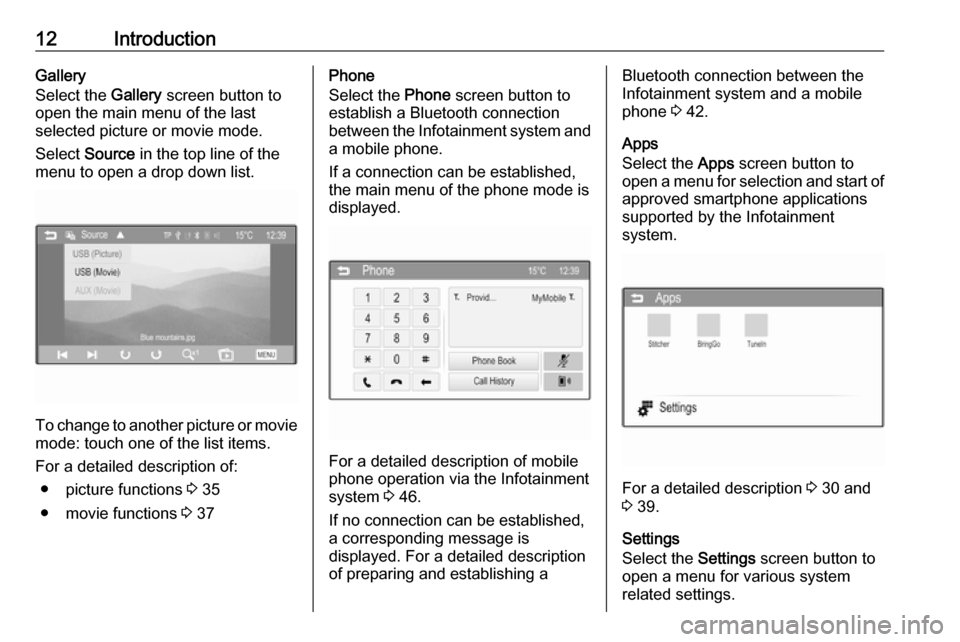
12IntroductionGallery
Select the Gallery screen button to
open the main menu of the last
selected picture or movie mode.
Select Source in the top line of the
menu to open a drop down list.
To change to another picture or movie
mode: touch one of the list items.
For a detailed description of: ● picture functions 3 35
● movie functions 3 37
Phone
Select the Phone screen button to
establish a Bluetooth connection
between the Infotainment system and
a mobile phone.
If a connection can be established,
the main menu of the phone mode is
displayed.
For a detailed description of mobile
phone operation via the Infotainment
system 3 46.
If no connection can be established,
a corresponding message is
displayed. For a detailed description
of preparing and establishing a
Bluetooth connection between the
Infotainment system and a mobile phone 3 42.
Apps
Select the Apps screen button to
open a menu for selection and start of
approved smartphone applications
supported by the Infotainment
system.
For a detailed description 3 30 and
3 39.
Settings
Select the Settings screen button to
open a menu for various system
related settings.
Page 13 of 101
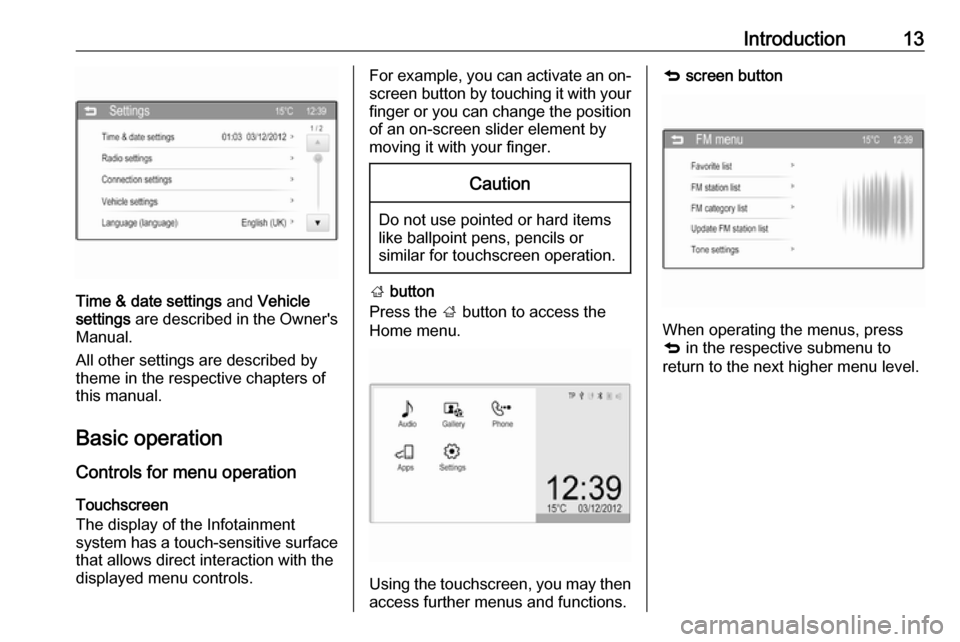
Introduction13
Time & date settings and Vehicle
settings are described in the Owner's
Manual.
All other settings are described by
theme in the respective chapters of
this manual.
Basic operation Controls for menu operationTouchscreen
The display of the Infotainment
system has a touch-sensitive surface
that allows direct interaction with the
displayed menu controls.
For example, you can activate an on-
screen button by touching it with your
finger or you can change the position of an on-screen slider element by
moving it with your finger.Caution
Do not use pointed or hard items
like ballpoint pens, pencils or
similar for touchscreen operation.
; button
Press the ; button to access the
Home menu.
Using the touchscreen, you may then
access further menus and functions.
q screen button
When operating the menus, press
q in the respective submenu to
return to the next higher menu level.
Page 14 of 101
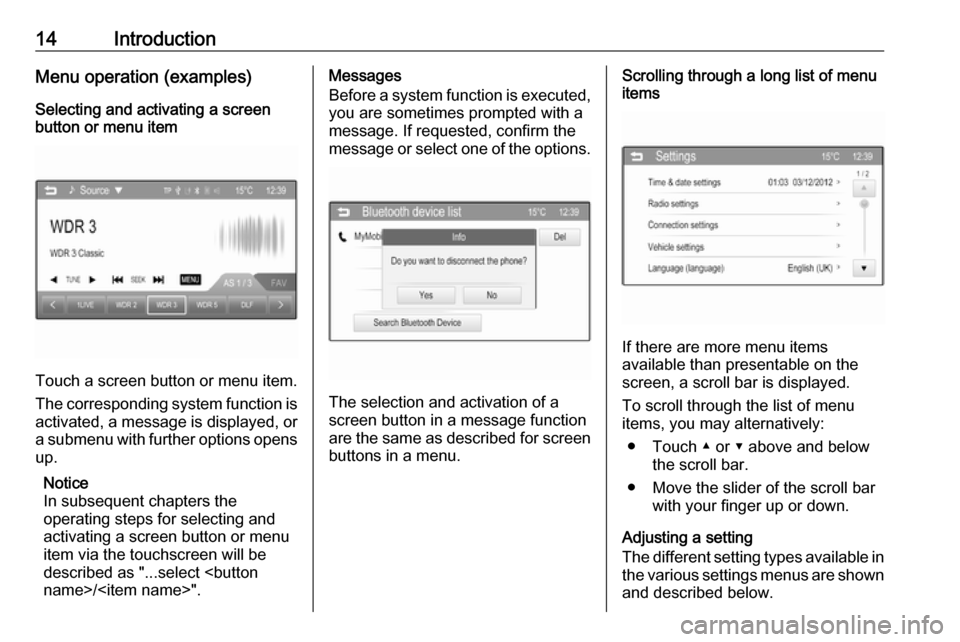
14IntroductionMenu operation (examples)Selecting and activating a screen
button or menu item
Touch a screen button or menu item.
The corresponding system function is activated, a message is displayed, or
a submenu with further options opens up.
Notice
In subsequent chapters the
operating steps for selecting and
activating a screen button or menu
item via the touchscreen will be
described as "...select
Messages
Before a system function is executed, you are sometimes prompted with a
message. If requested, confirm the
message or select one of the options.
The selection and activation of a
screen button in a message function
are the same as described for screen
buttons in a menu.
Scrolling through a long list of menu
items
If there are more menu items
available than presentable on the
screen, a scroll bar is displayed.
To scroll through the list of menu
items, you may alternatively:
● Touch ▲ or ▼ above and below the scroll bar.
● Move the slider of the scroll bar with your finger up or down.
Adjusting a setting
The different setting types available in the various settings menus are shown
and described below.
Page 16 of 101
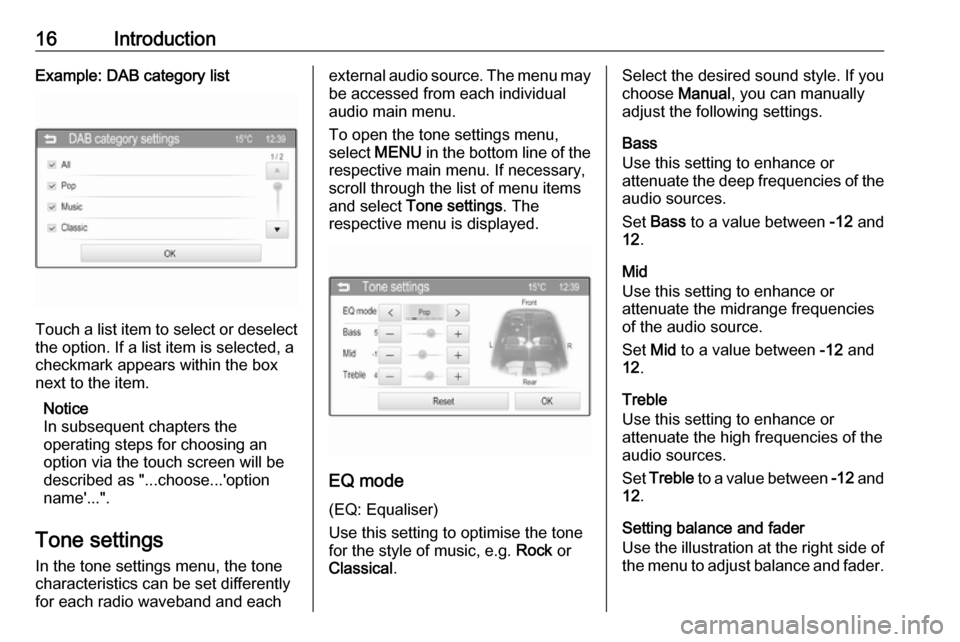
16IntroductionExample: DAB category list
Touch a list item to select or deselectthe option. If a list item is selected, a
checkmark appears within the box
next to the item.
Notice
In subsequent chapters the
operating steps for choosing an
option via the touch screen will be
described as "...choose...'option
name'...".
Tone settings
In the tone settings menu, the tone
characteristics can be set differently
for each radio waveband and each
external audio source. The menu may be accessed from each individual
audio main menu.
To open the tone settings menu,
select MENU in the bottom line of the
respective main menu. If necessary,
scroll through the list of menu items
and select Tone settings . The
respective menu is displayed.
EQ mode
(EQ: Equaliser)
Use this setting to optimise the tone for the style of music, e.g. Rock or
Classical .
Select the desired sound style. If you
choose Manual, you can manually
adjust the following settings.
Bass
Use this setting to enhance or
attenuate the deep frequencies of the
audio sources.
Set Bass to a value between -12 and
12 .
Mid
Use this setting to enhance or
attenuate the midrange frequencies
of the audio source.
Set Mid to a value between -12 and
12 .
Treble
Use this setting to enhance or
attenuate the high frequencies of the
audio sources.
Set Treble to a value between -12 and
12 .
Setting balance and fader
Use the illustration at the right side of
the menu to adjust balance and fader.
Page 17 of 101
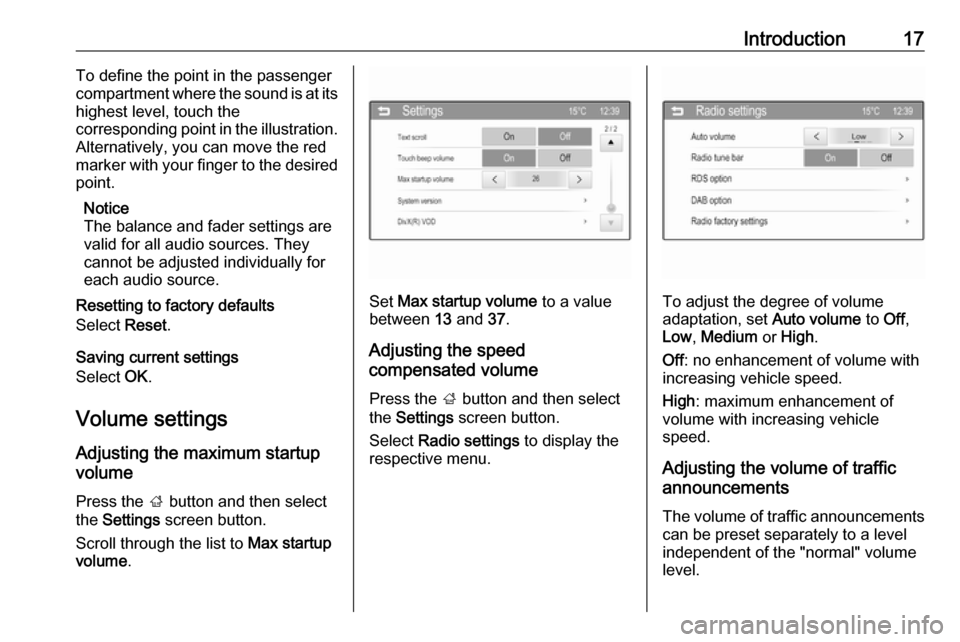
Introduction17To define the point in the passenger
compartment where the sound is at its
highest level, touch the
corresponding point in the illustration.
Alternatively, you can move the red
marker with your finger to the desired point.
Notice
The balance and fader settings are
valid for all audio sources. They cannot be adjusted individually for
each audio source.
Resetting to factory defaults
Select Reset.
Saving current settings
Select OK.
Volume settings Adjusting the maximum startup
volume
Press the ; button and then select
the Settings screen button.
Scroll through the list to Max startup
volume .
Set Max startup volume to a value
between 13 and 37.
Adjusting the speed
compensated volume
Press the ; button and then select
the Settings screen button.
Select Radio settings to display the
respective menu.To adjust the degree of volume
adaptation, set Auto volume to Off,
Low , Medium or High .
Off : no enhancement of volume with
increasing vehicle speed.
High : maximum enhancement of
volume with increasing vehicle
speed.
Adjusting the volume of traffic
announcements
The volume of traffic announcements
can be preset separately to a level
independent of the "normal" volume
level.
Page 18 of 101
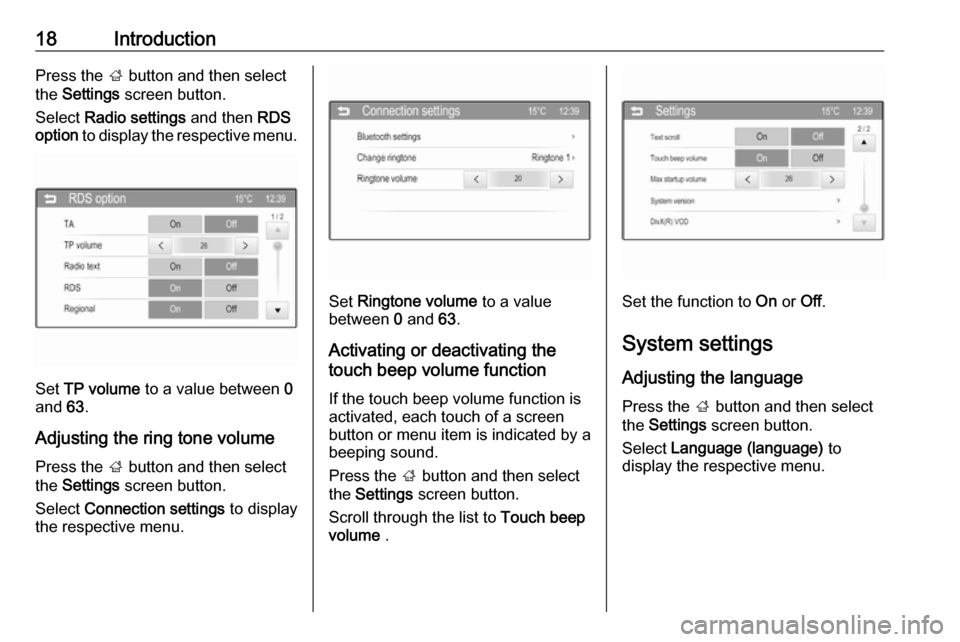
18IntroductionPress the ; button and then select
the Settings screen button.
Select Radio settings and then RDS
option to display the respective menu.
Set TP volume to a value between 0
and 63.
Adjusting the ring tone volume
Press the ; button and then select
the Settings screen button.
Select Connection settings to display
the respective menu.
Set Ringtone volume to a value
between 0 and 63.
Activating or deactivating the
touch beep volume function
If the touch beep volume function is
activated, each touch of a screen
button or menu item is indicated by a
beeping sound.
Press the ; button and then select
the Settings screen button.
Scroll through the list to Touch beep
volume .Set the function to On or Off.
System settings Adjusting the languagePress the ; button and then select
the Settings screen button.
Select Language (language) to
display the respective menu.
Page 19 of 101
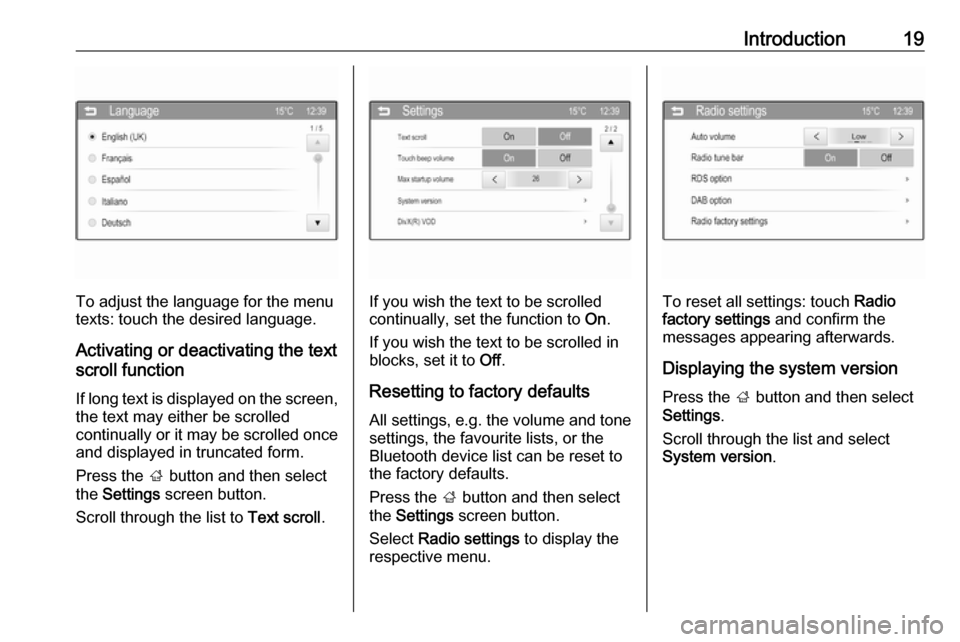
Introduction19
To adjust the language for the menu
texts: touch the desired language.
Activating or deactivating the text
scroll function
If long text is displayed on the screen,
the text may either be scrolled
continually or it may be scrolled once
and displayed in truncated form.
Press the ; button and then select
the Settings screen button.
Scroll through the list to Text scroll.If you wish the text to be scrolled
continually, set the function to On.
If you wish the text to be scrolled in
blocks, set it to Off.
Resetting to factory defaults All settings, e.g. the volume and tone
settings, the favourite lists, or the
Bluetooth device list can be reset to
the factory defaults.
Press the ; button and then select
the Settings screen button.
Select Radio settings to display the
respective menu.To reset all settings: touch Radio
factory settings and confirm the
messages appearing afterwards.
Displaying the system version Press the ; button and then select
Settings .
Scroll through the list and select
System version .
Page 22 of 101
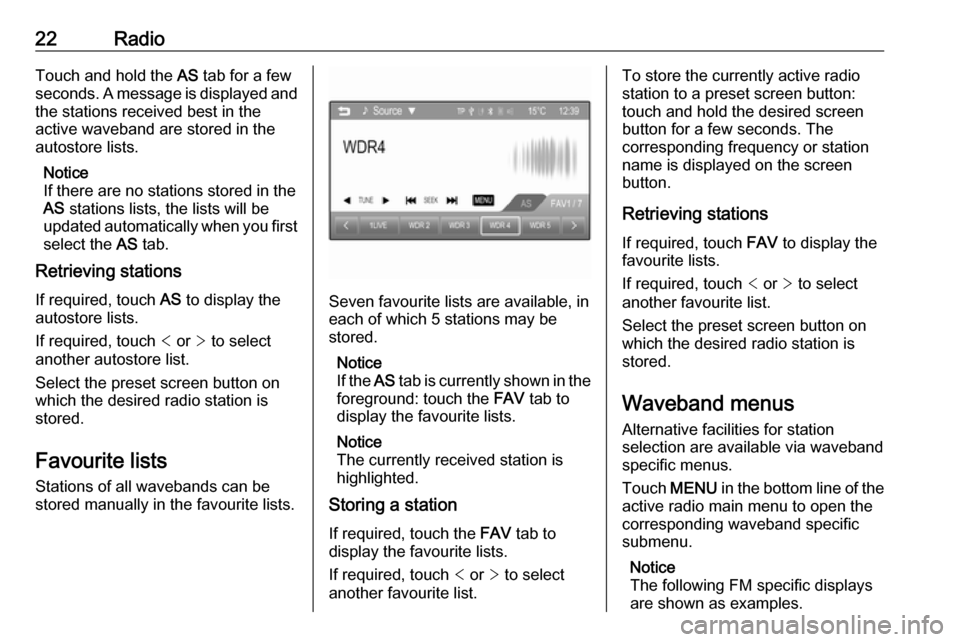
22RadioTouch and hold the AS tab for a few
seconds. A message is displayed and
the stations received best in the
active waveband are stored in the
autostore lists.
Notice
If there are no stations stored in the
AS stations lists, the lists will be
updated automatically when you first
select the AS tab.
Retrieving stations
If required, touch AS to display the
autostore lists.
If required, touch < or > to select
another autostore list.
Select the preset screen button on
which the desired radio station is
stored.
Favourite lists
Stations of all wavebands can be
stored manually in the favourite lists.
Seven favourite lists are available, in each of which 5 stations may be
stored.
Notice
If the AS tab is currently shown in the
foreground: touch the FAV tab to
display the favourite lists.
Notice
The currently received station is
highlighted.
Storing a station
If required, touch the FAV tab to
display the favourite lists.
If required, touch < or > to select
another favourite list.
To store the currently active radio
station to a preset screen button:
touch and hold the desired screen
button for a few seconds. The
corresponding frequency or station
name is displayed on the screen
button.
Retrieving stations
If required, touch FAV to display the
favourite lists.
If required, touch < or > to select
another favourite list.
Select the preset screen button on
which the desired radio station is
stored.
Waveband menus Alternative facilities for station
selection are available via waveband
specific menus.
Touch MENU in the bottom line of the
active radio main menu to open the
corresponding waveband specific
submenu.
Notice
The following FM specific displays
are shown as examples.
Page 23 of 101

Radio23
Favorite list
Select Favorite list to display all
stations currently stored in the
favourites lists.
Select the desired station.
Notice
The currently received radio station
is indicated by the l symbol next to
the station name.
Station lists
Within a waveband menu, select astationlist, e.g. FM station list . All
receivable stations of the relevant
waveband and in the current
reception area are displayed.
Select the desired station.
Notice
The currently received radio station
is indicated by the l symbol next to
the station name.
Category lists
Numerous radio stations broadcast a
PTY code, which specifies the type of programme transmitted (e.g. news).
Some stations also change the PTY
code depending on the content which
is currently transmitted.
The Infotainment system stores these stations, sorted by programme type in
the corresponding category list.
Notice
The category list submenu item is
not available for the AM waveband.
To search for a programme type
determined by the stations, select the
waveband specific category list
option.
Page 24 of 101

24Radio
A list of programme types currently
available is displayed.
Notice
For the DAB waveband, only the
selected categories 3 26 are
displayed in the category list.
Select the desired programme type. A
list of stations is displayed
transmitting a programme of the
selected type.
Select the desired station.
Notice
The currently received radio station
is indicated by the l symbol next to
the station name.
Update station lists
If the stations stored in a waveband
specific station list can no longer be
received, select the respective menu
item to update the station list in the
waveband menu, e.g. Update FM
station list .
Notice
If a waveband-specific station list is
updated, the corresponding
category list is also updated.
A station search is started and a
corresponding message is displayed.
Once the search is finished, the
respective station list is displayed.
Notice
The currently received radio station
is indicated by the l symbol next to
the station name.
Tone settings
For a detailed description of the Tone
settings menu 3 16.Radio data system (RDS)
RDS is a service of FM stations that
considerably facilitates the finding of
the desired station and its fault-free
reception.
Advantages of RDS ● On the display, the programme name of the station appears
instead of its frequency.
● During a station search, the Infotainment system tunes in to
RDS stations only.
● The Infotainment system always tunes into the best receivable
broadcasting frequency of the set station by means of AF
(alternative frequency).
● Depending on the station that is received, the Infotainment
system displays radio text that
can contain e.g. information
about the current programme.
RDS option menu
To open the menu for the RDS
configuration: